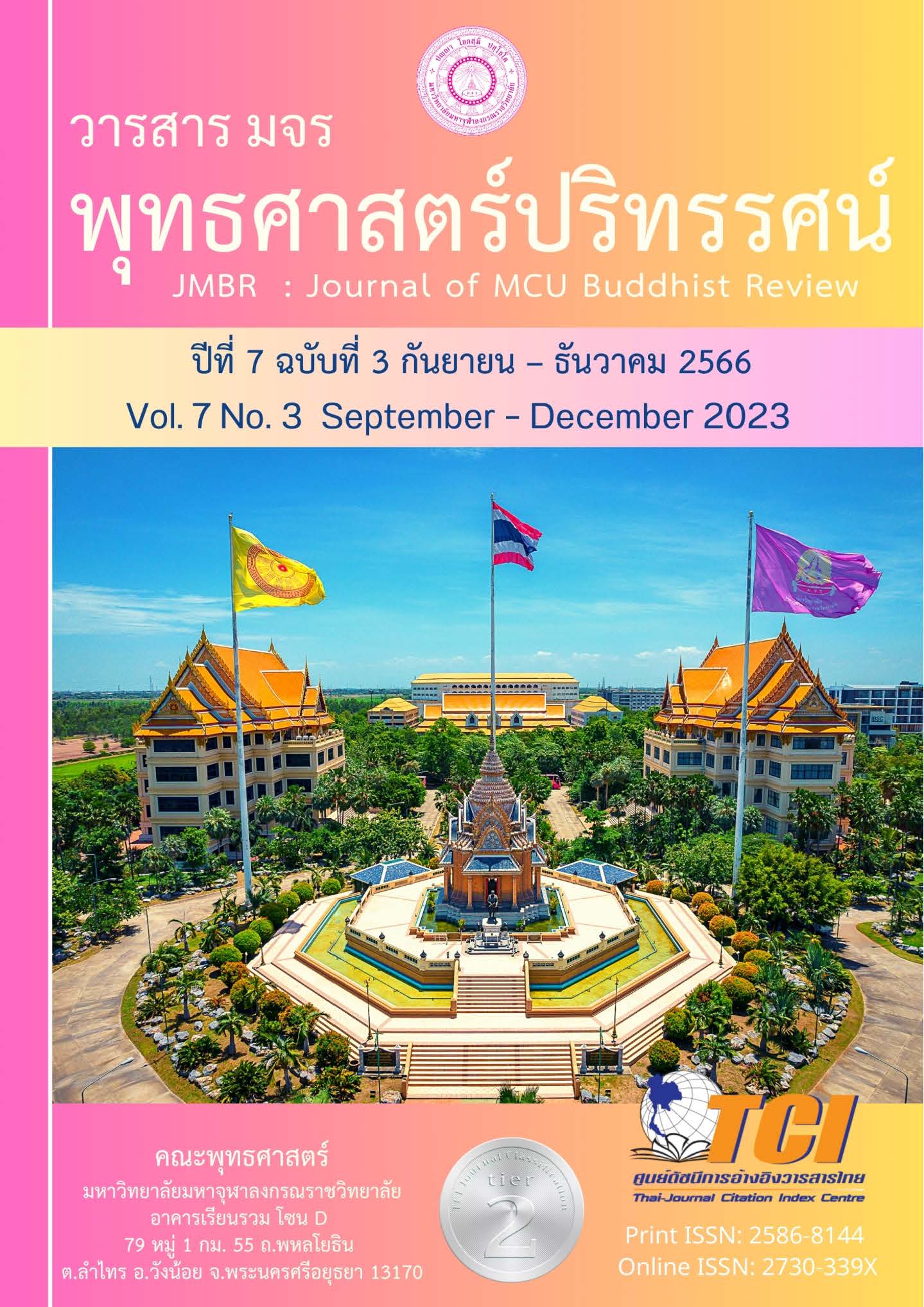การประยุกต์ใช้มหาสติปัฏฐานเพื่อการพัฒนาศักยภาพของมนุษย์ในยุคดิจิทัล
Main Article Content
บทคัดย่อ
บทความวิชาการนี้ มีวัตถุประสงค์เพื่อนำเสนอแนวทางการประยุกต์หลักมหาสติปัฏฐานมาใช้ให้เกิดประโยชน์และมีประสิทธิภาพ ในการพัฒนาคุณภาพชีวิตของมนุษย์ในสังคมแห่งยุคดิจิทัล มีการนำเสนอแนวทางและแก่นของมหาสติปัฏฐานซึ่งมุ่งการพัฒนาในสี่ด้านหลัก ได้แก่ ร่างกาย การรับรู้ จิตใจ และสภาวะธรรม สติปัฏฐานจะเป็นกลไกความเชื่อมโยงการแก้ไขปัญหา 1) ทางกายภาพ การประยุกต์มหาสติ- ปัฎฐานเรื่องกายเป็นการช่วยพัฒนา ด้านการเข้าใจร่างกายให้สอดคล้องกับโลกในยุคใหม่ที่บีบคั้นให้เกิดความทุกข์ทางกาย เมื่อเข้าใจกายก็จะพัฒนากายนั้นรองรับต่อความเป็นจริงที่เกิดต่อชีวิตได้ดีขึ้น 2) ทางเวทนา ช่วยพัฒนาให้เกิดความรับรู้ความรู้สึกว่าเป็นสุขและทุกข์นั้นว่าไม่ใช่ของเรา และปล่อยวาง หรือเข้าใจว่าควรจะรู้ว่าทุกข์นั้นเป็นเรื่องที่ควรเข้าใจ มากกว่าจะยึดถือไว้ 3) ทางจิต ช่วยให้เข้าใจธรรมชาติได้ชัดเจนและสามารพัฒนาจิตให้มีคุณภาพสูงขึ้นโดยลำดับ 4) ทางสภาวะธรรม ช่วยให้จิตกำจัดอวิชชาและกิเลสได้ นอกจากนี้ การชี้แนะแนวทางการปฏิบัติเพื่อให้เกิดทางแก้ปัญหาการดำรงชีวิตรวมเทคนิคต่างๆที่ออกแบบมาเพื่อช่วยให้บุคคลปลูกฝังการรับรู้อย่างลึกซึ้งเกี่ยวกับร่างกาย ความรู้สึก จิตใจ และธรรมชาติของความเป็นจริงของตัวเอง ความทุกข์เป็นสิ่งที่เกิดขึ้นได้ ในสังคมปัจจุบันมีการกดดันจากภายนอกและภายใน เราสามารถปรับเปลี่ยนมุมมองและทัศนคติของเราต่อสิ่งต่างๆ เพื่อลดความทุกข์ในชีวิตประจำวันได้โดยการปรับแนวทางปฏิบัติมหาสติปัฏฐานนี้ให้มีความสมดุลในชีวิตของเราได้ทั้ง 4 ด้านโดยประยุกต์เข้ากับการใช้ชีวิตในยุคดิจิทัล เพราะมันเป็นวิธีการพัฒนาจิตใจและการไตรตรองเพื่อเพิ่มความสงบและความสุขในชีวิต บทความนี้ ได้นำเสนอแนวทางการปฏิบัติเพื่อให้เกิดคุณูปการแก่การดำรงชีวิตในโลกสมัยใหม่แก่คนหนุ่มสาวได้เป็นอย่างดี เพราะผู้เขียนได้นำเสนอหลักการและสารสำคัญของมหาสติปัฏฐานไว้เป็นบรรทัดฐานในการปฏิบัติไว้ด้วย
Article Details

อนุญาตภายใต้เงื่อนไข Creative Commons Attribution-NonCommercial-NoDerivatives 4.0 International License.
- บทความที่ได้รับการตีพิมพ์เป็นลิขสิทธิ์ของวารสาร มจร พุทธศาสตร์ปริทรรศน์
- ข้อความใดๆ ที่ปรากฎในบทความที่ได้รับการตีพิมพ์ในวารสาร ถือเป็นความรับผิดชอบของผู้เขียนบทความ และข้อคิดเห็นนั้นไม่ถือว่าเป็นทัศนะและความรับผิดชอบของกองบรรณาธิการวารสาร มจร พุทธศาสตร์ปริทรรศน์
เอกสารอ้างอิง
มหาจุฬาลงกรณราชวิทยาลัย. (2539). พระไตรปิฎกภาษาไทย ฉบับมหาจุฬาลงกรณราชวิทยาลัย. กรุงเทพฯ: มหาจุฬาลงกรณราชวิทยาลัย.
มหาจุฬาลงกรณราชวิทยาลัย. (2539). พระอภิธรรมปิฎก ฉบับมหาจุฬาลงกรณราชวิทยาลัย. กรุงเทพฯ: มหาจุฬาลงกรณราชวิทยาลัย.
พระปราโมทย์ ปาโมชฺโช. ธรรมะเพื่อความพ้นทุกข์. สืบค้น 7 กรกฎาคม 2566 จาก https://www.dhamma .com/handling-the-noise/
พระพรหมคุณาภรณ์ (ป.อ.ปยุตฺโต). (2546). พจนานุกรมพุทธศาสน์ ฉบับประมวลศัพท์. พิมพ์ครั้งที่ 12. สืบค้น 7 กรกฎาคม 2566 จาก http://thesis.rru.ac.th/files/pdf/503_2016_01_12_113333.pdf
พระพรหมคุณาภรณ์ (ป.อ.ปยุตฺโต). (2559). พจนานุกรมพุทธศาสตร์ ฉบับประมวลธรรม. พิมพ์ครั้งที่ 34. กรุงเทพฯ: มูลนิธิการศึกษาเพื่อสันติภาพ.
พุทธทาสภิกขุ. สติปัฏฐาน เครื่องมือให้บรรลุมรรค ผล นิพพาน. สืบค้น 7 กรกฎาคม 2566 จาก https://www .youtube.com/watch?v=nQ5QOC514c4
สมเด็จพระพุทธโฆษาจารย์ (ป.อ.ปยุตฺโต). สมาธิแบบพุทธ. สืบค้น 7 กรกฎาคม 2566 จาก https://www.wa tnyanaves.net/th/book-reading/431/14
Buddhadāsa Bhikkhu. (1996). Mindfulness with Breathing. Boston: Wisdom Publications.
The Maha-Satipatthana Sutta-First Day สืบค้น 7 สิงหาคม 2566 จาก https://www.dalailama.com /news/2021/the-maha-satipatthana-sutta-first-day


